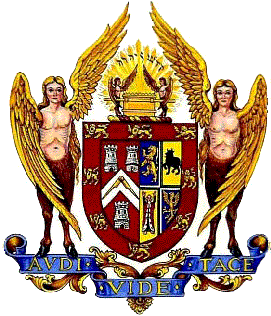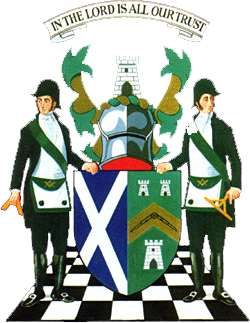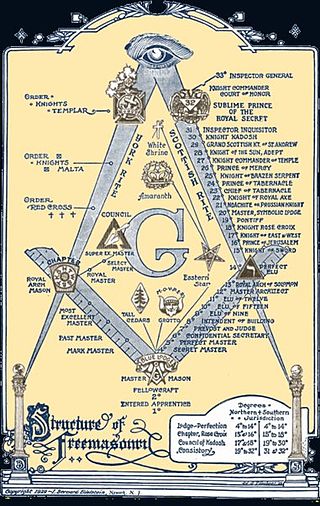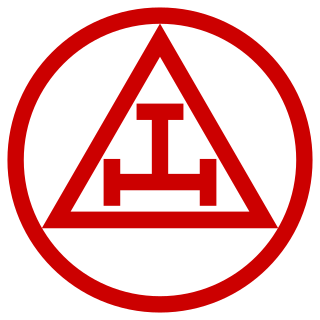Organisation
The Grand Lodge is led by an elected Grand Master, assisted by a Deputy Grand Master and an Assistant Grand Master, with a Grand Team.
The Grand Lodge is further organised into 4 Regions, each led by a Regional Grand Counsellor (RGC), which are in turn organised into various Districts, led by a District Grand Inspector of Workings (DGIW), comprising groups of lodges based on geography. Lodges meet in various buildings, ranging from individual lodge buildings to major city or urban centres, such as in Canberra.
The Grand Secretary heads the administration of the Grand Lodge from the headquarters at 279 Castlereagh Street, Sydney, on the north-west side of the corner with Goulburn Street.
History
Freemasonry came to New South Wales with the regiments of the British Army soon after the First Fleet in 1788. It was banned by Governor King because of suspicions of republicanism. [2]
The first stationary lodge, The Australian Social Lodge No.260 (Irish Constitution), was established by lodges working under Irish travelling warrants that were attached British regiments garrisoning the settlement in New South Wales. Lodge No.227 (attached to the 46th Regiment) and Lodge No.218 (attached to the 48th Regiment) admitted a number of civilians to membership and assisted in the dedication of The Australian Social Lodge in August 1820. In 1824, Lodge Leinster Marine of Australia, No.266 (Irish Constitution) was formed.
The first lodge under the English Constitution was warranted in June 1828 as the Lodge of Australia No.820. The first Scottish lodge was established in 1844 in Melbourne, then known as the Port Phillip Settlement and still part of New South Wales. It was not until 1851 that the first Scottish Lodge, Lodge of St. Andrew (No.358), was established in Sydney.
The first English Provincial Grand Lodge was opened in Sydney on 10 May 1849, Bro. John Williams being the first Provincial Grand Master. The institution grew and prospered; English lodges, The Maitland Lodge of Unity No.804 had been opened in 1847, followed by The Australian Lodge of Harmony No.814 (Sydney) in 1848 and the Armidale Lodge of Unity No.865 in 1851.
The Grand Lodge of Ireland and the Grand Lodge of Scotland were also warranting lodges in New South Wales, and creating their own provincial Grand Lodges. However, there was to become a growing level of dissatisfaction with the home Grand Lodges (England, Scotland and Ireland) due to the tyranny of distance and also the amount of money being sent away from the Colony. This dissatisfaction eventually led to the establishment of the Grand Lodge of New South Wales by three Irish Lodges and five Scottish Lodges on 3 December 1877. The new breakaway Grand Lodge was not favourably received by the home Grand Lodges and was not officially recognised until the union in 1888, although it did receive recognition from a majority of the world's Grand Lodges, especially from the various jurisdictions in the United States of America.
In the following 11 years, although there was much disharmony between the three organisations, the three constitutions continued to warrant lodges and membership grew. By the time of the formation of the United Grand Lodge in 1888, the Grand Lodge of New South Wales had fifty-one lodges on its register. Following Scottish tradition, The Australian Social Lodge, being the mother lodge of masons in New South Wales, was given the number 0 on the register.
On 16 August 1888, after considerable consultation, the Masters and Wardens of the one hundred and seventy-six lodges assembled, the articles of union were again adopted, and the " United Grand Lodge of New South Wales " declared to be duly constituted and established. [3] The first Grand Master was Lord Carrington, Governor of New South Wales.
On 12 August 2015 the Grand Lodge installed the youngest Grand Master to preside over the jurisdiction (New South Wales and the Australian Capital Territory), James Robert Melville. Melville was 43 years old at the day of his installation and served as Grand Master for three years until August 2018. [4]

Freemasonry or Masonry refers to fraternal organisations that trace their origins to the local guilds of stonemasons that, from the end of the 14th century, regulated the qualifications of stonemasons and their interaction with authorities and clients. Modern Freemasonry broadly consists of two main recognition groups: Regular Freemasonry, which insists that a volume of scripture be open in a working lodge, that every member professes belief in a Supreme Being, that no women be admitted, and that the discussion of religion and politics do not take place within the lodge; and Continental Freemasonry, which consists of the jurisdictions that have removed some, or all, of these restrictions.

A Masonic lodge, often termed a private lodge or constituent lodge, is the basic organisational unit of Freemasonry. It is also commonly used as a term for a building in which such a unit meets. Every new lodge must be warranted or chartered by a Grand Lodge, but is subject to its direction only in enforcing the published constitution of the jurisdiction. By exception the three surviving lodges that formed the world's first known grand lodge in London have the unique privilege to operate as time immemorial, i.e., without such warrant; only one other lodge operates without a warrant – the Grand Stewards' Lodge in London, although it is not also entitled to the "time immemorial" title. A Freemason is generally entitled to visit any lodge in any jurisdiction in amity with his own. In some jurisdictions this privilege is restricted to Master Masons. He is first usually required to check, and certify, the regularity of the relationship of the Lodge – and be able to satisfy that Lodge of his regularity of membership. Freemasons gather together as a Lodge to work the three basic Degrees of Entered Apprentice, Fellowcraft, and Master Mason.
The history of Freemasonry encompasses the origins, evolution and defining events of the fraternal organisation known as Freemasonry. It covers three phases. Firstly, the emergence of organised lodges of operative masons during the Middle Ages, then the admission of lay members as "accepted" or "speculative" masons, and finally the evolution of purely speculative lodges, and the emergence of Grand Lodges to govern them. The watershed in this process is generally taken to be the formation of the first Grand Lodge in London in 1717. The two difficulties facing historians are the paucity of written material, even down to the 19th century, and the misinformation generated by masons and non-masons alike from the earliest years.
In Freemasonry, regularity is one of the factors by which individual Grand Lodges judge whether to recognise one another for the purposes of allowing formal interaction at the Grand Lodge level and visitation by members of other jurisdictions. Each individual Grand Lodge determines which other Grand Lodges it considers Regular.

The United Grand Lodge of England (UGLE) is the governing Masonic lodge for the majority of freemasons in England, Wales, and the Commonwealth of Nations. Claiming descent from the Masonic Grand Lodge formed 24 June 1717 at the Goose & Gridiron Tavern in London, it is considered to be the oldest Masonic Grand Lodge in the world, together with the Grand Lodge of Scotland, and the Grand Lodge of Ireland.

The Grand Lodge of Ireland is the second most senior Grand Lodge of Freemasons in the world, and the oldest in continuous existence. Since no specific record of its foundation exists, 1725 is the year celebrated in Grand Lodge anniversaries, as the oldest reference to Grand Lodge of Ireland comes from the Dublin Weekly Journal of 26 June 1725. This describes a meeting of the Grand Lodge to install the new Grand Master, The 1st Earl of Rosse, on 24 June. The Grand Lodge has regular Masonic jurisdiction over 13 Provincial Grand Lodges covering all the Freemasons of the island of Ireland, and another 11 provinces worldwide.

Freemasonry in Malta has a lengthy history dating from the eighteenth century. The main masonic influences have been from the United Grand Lodge of England, the Grand Lodge of Scotland, and the Grand Lodge of Ireland. Today Regular Freemasonry is under the jurisdiction of the Sovereign Grand Lodge of Malta, formed in 2004.

The Order of Mark Master Masons is an appendant order of Freemasonry that exists in some Masonic jurisdictions, and confers the degrees of Mark Mason and Mark Master.

The Grand Lodge of Antient Free and Accepted Masons of Scotland is the governing body of Freemasonry in Scotland. It was founded in 1736. About one third of Scotland's lodges were represented at the foundation meeting of the Grand Lodge.

There are many organisations and orders which form part of the widespread fraternity of Freemasonry, each having its own structure and terminology. Collectively these may be referred to as Masonic bodies, Masonic orders, Concordant bodies or appendant bodies of Freemasonry.
The Province of South Australia was established by an Act of the British Parliament and was assented to by King William IV on 15 August 1834. Freemasonry became included in the plans for the proposed new settlement with the establishment of a new Lodge in England. On 22 October 1834, the South Australian Lodge of Friendship, No 613 E.C. was warranted and met in London for the first time on 27 November.

The Ancient Grand Lodge of England, as it is known today, or The Grand Lodge of the Most Ancient and Honourable Fraternity of Free and Accepted Masons as they described themselves on their warrants, was a rival Grand Lodge to the Premier Grand Lodge of England. It existed from 1751 until 1813 when the United Grand Lodge of England was created from the two Grand Lodges. They are now called the Antients, in contrast to the Moderns, the original Grand Lodge which its critics, notably Laurence Dermott, said had moved away from the ritual of Scotland, Ireland, and now the Antient Grand Lodge. This Grand Lodge was also informally called the Atholl Grand Lodge because the Third and Fourth Dukes of Atholl presided over it as Grand Masters for half of its 62-year existence.

The organisation now known as the Premier Grand Lodge of England was founded on 24 June 1717 as the Grand Lodge of London and Westminster. Originally concerned with the practice of Freemasonry in London and Westminster, it soon became known as the Grand Lodge of England. Because it was the first Masonic Grand Lodge to be created, modern convention now calls it the Premier Grand Lodge of England in order to distinguish it from the Most Ancient and Honourable Society of Free and Accepted Masons according to the Old Constitutions, usually referred to as the Ancient Grand Lodge of England, and the Grand Lodge of All England Meeting at York. It existed until 1813, when it united with the Ancient Grand Lodge of England to create the United Grand Lodge of England.

This is a chronology of the formation of "regular" or "mainstream" Masonic Grand Lodges in North America, descending from the Premier Grand Lodge of England or its rival, the Antient Grand Lodge of England. A Grand Lodge is the governing body that supervises "Craft" Freemasonry in a particular jurisdiction or geographical area.
Provincial Grand Master, sometimes called District Grand Master or Metropolitan Grand Master, is a fraternal office held by the head of a Provincial Grand Lodge, who is directly appointed by the organisation's Grand Master.

The Royal Arch is a degree of Freemasonry. The Royal Arch is present in all main masonic systems, though in some it is worked as part of Craft ('mainstream') Freemasonry, and in others in an appendant ('additional') order. Royal Arch Masons meet as a Chapter; in the Supreme Order of the Royal Arch as practised in the British Isles, much of Europe and the Commonwealth, Chapters confer the single degree of Royal Arch Mason.
Freemasonry in Scotland in lodges chartered by the Grand Lodge of Scotland comprises the Scottish Masonic Constitution as regular Masonic jurisdiction for the majority of freemasons in Scotland. There are also lodges operating under the Scottish Masonic Constitution in countries outside of Scotland. Many of these are countries linked to Scotland and the United Kingdom through the Commonwealth of Nations and prior colonies and other settlements of the British Empire although there are several lodges in countries such as Lebanon, Belgium, Chile and Peru, which do not have such connections.

Maitland Lodge of Unity Masonic Hall and Lodge is a heritage-listed masonic lodge and masonic hall at 5 Victoria Street, Maitland, City of Maitland, New South Wales, Australia. It was designed by J. W. Pender and built from 1886 to 1927. The property is owned by Maitland Lodge of Unity. It was added to the New South Wales State Heritage Register on 19 December 2014.
The history of Freemasonry in Ghana can be traced to the early nineteenth century when the first Masonic lodge was consecrated in the country. The practice of Freemasonry was imported to the then Gold Coast and other Commonwealth realms by European residents in the nation during the British colonial era. Most of the lodges in Ghana are governed by the United Grand Lodge of England (UGLE) and Wales, Grand Lodge of Scotland and the Grand Lodge of Ireland. Similar to their sister organisations worldwide, Ghanaian masonic fraternities are nonsectarian, with proceedings of the societies being strictly apolitical and non–religious.
















